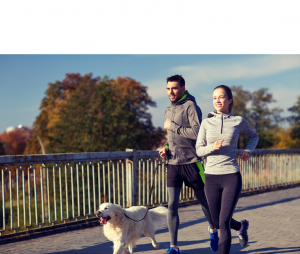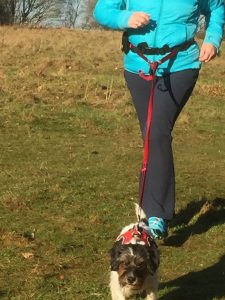Running, or Cycling, with Your Dog.
Thinking about healthy living? This Holidays4Dogs article will take a look at running, or cycling, with your dog. Both fun sports for dogs and humans alike as well as being a great way for you and your four-legged pal to keep fit and well.
Running with your dog.
Running with your dog can be a good overall work-out for you and your dog. Cani-cross, is actually a recognised sport, so you and your pooch can even compete at events around the country.
work-out for you and your dog. Cani-cross, is actually a recognised sport, so you and your pooch can even compete at events around the country.
Although running is great exercise, its always best to start slowly. Never take young puppies running, especially large breeds, as this can impact on their developing muscles and bones.
Problems can occur later in life, if they are over exercised when young. Smaller breeds are often quite capable of running too. However, there are some considerations to consider beforehand. If you are wondering if you can take your small dog jogging, head over to our other article here.
Your dog should be at least twelve months, or older, before running on a ‘professional’ level. Your dog should not be overweight, or have any underlying health conditions. If you are unsure, speak to your vet before you start training.
Running can sometimes be useful for dogs that pull. Many dogs will pull their owners along because a human’s pace is so much slower than a dog.
Training.
Dogs tend to trot along when they want to get from A to B. However, it is still a good idea to practice some good lead manners before you start jogging, or running, properly. Teach your dog to stay on one side, or the other, rather than have him weave from side to side – as this could cause a trip hazard!
Make sure the lead is not too long, so this doesn’t create a hazard for other pedestrians. Always be aware of running in the heat, as dogs suffer from heat stroke just like people. Carry water with you, or make use of natural springs and streams, along a carefully chosen route.
There are many professional type harnesses and bungee lines for running with your dog. It makes good sense to utilise these if you intend to run with your dog on a daily basis.
Cani-cross equipment usually involves a harness and a line which attaches around your. This leaves you with your arms free while you run and helps you maintain better balance. The bungee attachment prevents any shocks, or jerks, if your dog should lurch forward.
When running, the dog is generally in front of you with the line kept taught. In the sport of cani-cross, the dog is meant to pull. Therefore, the sport is quite suited to dogs that naturally pull on the lead. It is also great for assisting owners on the up-hill sections of a run.
Running your dog in harness uses up a lot of energy, creates a strong bond between you and your dog and can, in fact, help with loose lead walking. If your dog is fence running at home, this behaviour can be a nuisance. If you want to know more about this, take a look at our other article here.
Cycling with your dog.
Bikejoring is becoming a fairly popular sport in the U.K. It involves cycling with your dog in front of a bicycle using specialist equipment. Some sled dogs are trained using bicycles and this dry-land sport was developed from other mushing and sled dog activities.
As with running, or jogging, you need to build up your dog’s fitness levels gradually. Cycling with your dog involves a little more training too. The dog needs to run in the correct position and be fairly obedient to follow direction instructions.
Start by walking your dog and pushing the bike. Set the seat lower than usual, so you can quickly place your feet on the ground if needed. The bike should be in good condition and the brakes well oiled.
You should not technically have your dog attached to a bicycle on public pavements and highways, including cycle tracks. Therefore, you will need to find some suitable areas such as forest tracks, or heath land, to cycle with your dog. Running on pavements should be avoided.
While it is common for huskies and other sled dog breeds to take part in bikejoring, many other breeds of dog take part.
Equipment.
There are associations and competitions all over the U.K. for bikejoring and many are organised alongside rig racing, making for an enjoyable and interesting day out.
You must run, or cycle, with your dog in a harness. Running harnesses are usually referred to as ‘X-back’ harnesses. They are not the usual walking harness you purchase in an ordinary pet shop. Specialist harnesses can be purchased on-line.
The next thing you will need is a good running line and a bungee which will absorb shocks. When bikejoring, the dog would normally run out in front of the bicycle.
However, some people use an antenna, or piece of pipe, to keep the line away from the front wheel. This is a pretty essential piece of equipment since it avoids the possibility of the cyclist ending up upside down in a hedge!
There are specialist attachments available to purchase on line which attach to the side of the bicycle, rather like an arm. These devices do not encourage the dog to pull so much as the dog runs alongside the bicycle. They usually include some sort of shock absorber.
Conclusion.
Running, or cycling, with your dog can be a really fun hobby. However, if you want to take things further there are plenty of opportunities to compete at all levels. Dogs and people, alike, can benefit greatly from these activities. Just remember to ensure you and your dog are fit and healthy before you begin. If in doubt, always seek advice from your vet.


